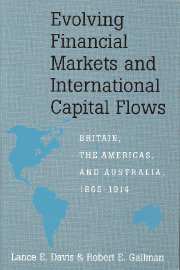 Evolving Financial Markets and International Capital Flows
Evolving Financial Markets and International Capital Flows Published online by Cambridge University Press: 18 August 2009
Introduction
Of the four frontier countries, the United States depended least on foreign capital. Although as late as the mid-1890s the annual net change in claims on foreigners was typically negative – on balance, foreigners were lending to the United States or acquiring American assets – the story had begun to change; the country was gradually becoming a creditor nation (Table 3:1-1). From 1897 until 1905 the United States, on net, exported capital in every year, and capital exports over the nine years totaled more than $1.5 billion. Over the years 1906 through 1913, however, the country briefly returned to its heretofore traditional role of capital importer. By the standard of these measures, the United States was a very modest net importer of capital in 1906, 1907, and 1909–1913, the inflows in all of these years but one amounting to less than 2 percent of domestic capital formation. Furthermore, even in the years before the mid-1890s, when Americans were frequently experiencing numerically large net capital imports, total foreign holdings of American assets and debts were probably never as large as 10 percent of the American domestic capital stock (Table 3:1-2). Compared with the cases of Australia, Argentina, and Canada, American development was largely a result of internal finance.
Nonetheless, it would be a major mistake to treat the American experience as though it had little relationship to the international capital flows of the nineteenth and early twentieth centuries.
To save this book to your Kindle, first ensure [email protected] is added to your Approved Personal Document E-mail List under your Personal Document Settings on the Manage Your Content and Devices page of your Amazon account. Then enter the ‘name’ part of your Kindle email address below. Find out more about saving to your Kindle.
Note you can select to save to either the @free.kindle.com or @kindle.com variations. ‘@free.kindle.com’ emails are free but can only be saved to your device when it is connected to wi-fi. ‘@kindle.com’ emails can be delivered even when you are not connected to wi-fi, but note that service fees apply.
Find out more about the Kindle Personal Document Service.
To save content items to your account, please confirm that you agree to abide by our usage policies. If this is the first time you use this feature, you will be asked to authorise Cambridge Core to connect with your account. Find out more about saving content to Dropbox.
To save content items to your account, please confirm that you agree to abide by our usage policies. If this is the first time you use this feature, you will be asked to authorise Cambridge Core to connect with your account. Find out more about saving content to Google Drive.